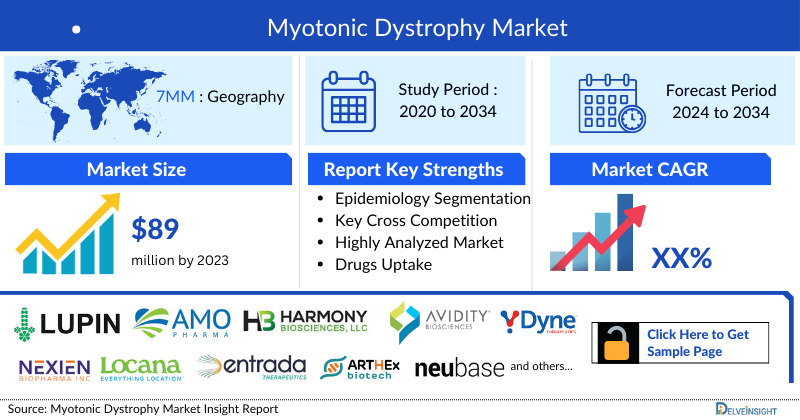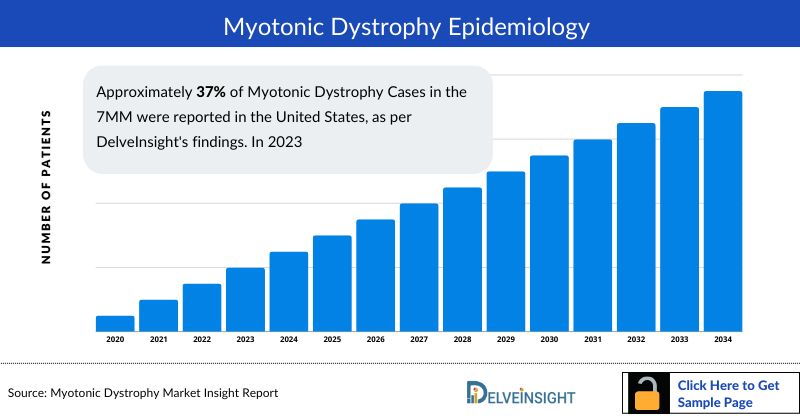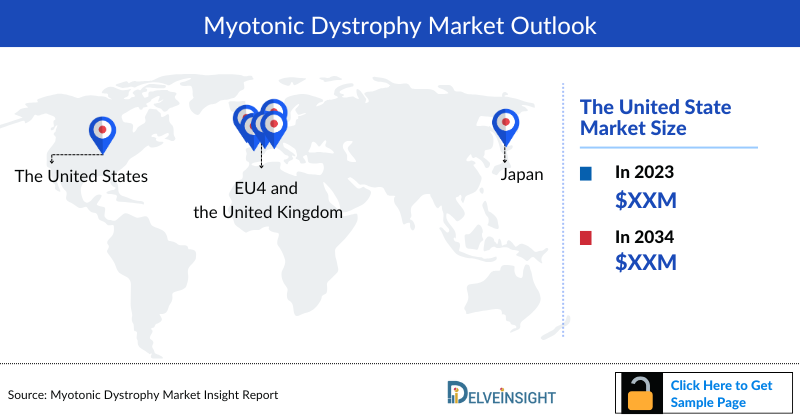Myotonic Dystrophy Market
- The Myotonic Dystrophy Market is projected to witness consistent growth throughout the forecast period (2024–2034). The Myotonic Dystrophy Treatment Market Size in the 7MM is expected to increase, driven by better diagnosis and the launch of emerging therapies.
- DelveInsight’s analysis estimates that among the total Myotonic Dystrophy Diagnosed Prevalent Cases in 7MM approximately 51% of cases were from the US. As per our estimations, in 2023, the US accounted for nearly 54,068 diagnosed prevalent cases of Myotonic Dystrophy.
- The total Myotonic Dystrophy Treatment Market is anticipated to experience growth during the forecast period due to the emergence of new and effective treatments, namely, Tideglusib (AMO-02).
- The Myotonic Dystrophy Therapeutics Market is projected to experience robust growth, at a significant compound annual growth rate (CAGR) of 18.4% from 2020 to 2034. This dynamic expansion reflects increasing demand for advanced treatment options and underscores the growing investment in addressing this serious condition.
- The Myotonic Dystrophy Therapeutics Market is shaped by several critical factors, including the increasing prevalence of genetic disorders and heightened awareness about rare diseases. Advances in genomic research and growing investments in rare disease therapies are driving market growth. Nonetheless, challenges such as limited funding for research, high costs of novel treatments, and rigorous regulatory hurdles remain significant obstacles. Moreover, the substantial unmet need for effective Myotonic Dystrophy treatments underscores a major gap in the current therapeutic landscape, presenting a prime opportunity for companies to innovate and address the needs of a diverse patient population.
Request for unlocking the sample page of the "Myotonic Dystrophy Treatment Market"
Key Factors Driving Myotonic Dystrophy Market
Myotonic Dystrophy Rising Prevalence
In 2023, the US accounted for approximately 54K diagnosed prevalent cases of Myotonic Dystrophy, representing 51% of total cases in the 7MM. The increasing awareness of rare genetic disorders, combined with improved diagnostic capabilities, is expected to drive further growth in diagnosed cases during the forecast period.
Myotonic Dystrophy Market Dynamics
The Myotonic Dystrophy therapeutics market is projected to grow at a robust CAGR of 18.4% from 2020 to 2034. This expansion is fueled by rising demand for advanced therapies, heightened awareness of rare diseases, and growing investment in genomic research. Novel treatments addressing the underlying causes of the disease are creating opportunities for market growth and improving patient outcomes.
Myotonic Dystrophy Treatment Landscape
Current management of Myotonic Dystrophy focuses on targeted therapies aimed at symptom control and disease modification. Innovations include Neonatal Fc Receptor inhibitors, complementing existing symptomatic treatments, and emerging therapies like Tideglusib (AMO-02) that target GSK3ß to normalize pathogenic mRNA levels. Companies such as AMO Pharma, Lupin Ltd., Harmony Biosciences, and Avidity Biosciences are leading research efforts in this area.
Myotonic Dystrophy Clinical Trials and Emerging Therapies
Tideglusib (AMO-02) is a clinical-stage investigational therapy for congenital Myotonic Dystrophy Type 1, shown to reduce pathogenic mRNA and normalize GSK3ß activity in preclinical models. Delpacibart etedesiran (AOC-1001/Del-desiran) by Avidity Biosciences is in Phase III HARBOR and ongoing MARINA-OLE trials, demonstrating dose-dependent reversal of disease progression by targeting DMPK mRNA in skeletal, cardiac, and smooth muscles. Fast Track designation by the FDA for DYNE-101 further highlights the dynamic clinical pipeline addressing unmet needs in Myotonic Dystrophy.
DelveInsight’s “Myotonic Dystrophy Market Insights, Epidemiology, and Market Forecast – 2034” report delivers an in-depth understanding of the myotonic dystrophy, historical and forecasted epidemiology and the Myotonic Dystrophy market trends in the United States, EU4 (Germany, France, Italy, and Spain) and the United Kingdom, and Japan.
The Myotonic Dystrophy Treatment Market Report provides current treatment practices, emerging drugs, market share of individual therapies, and current and forecasted 7MM Myotonic Dystrophy market size from 2020 to 2034. The report also covers current Myotonic Dystrophy treatment market practices/algorithms and unmet medical needs to curate the best of the opportunities and assesses the underlying potential of the market.
|
Study Period |
2020 to 2034 |
|
Forecast Period |
2024-2034 |
|
Geographies Covered |
|
|
Myotonic Dystrophy Drug Market |
|
|
Myotonic Dystrophy Treatment Market Size | |
|
Myotonic Dystrophy Companies |
|
Myotonic Dystrophy Treatment Market Disease: Understanding and Algorithm
Myotonic dystrophy is a form of muscular dystrophy, a group of disorders characterized by the weakness and degeneration of various voluntary muscles in the body. Each type of muscular dystrophy has distinct abnormalities, such as variations in muscle fiber size, muscle fiber necrosis, scar tissue formation, and inflammation, which can be observed in muscle biopsies from affected patients.There are two primary forms of myotonic dystrophy: type 1 and type 2. Myotonic dystrophy type 1 is commonly referred to as Steinert disease, named after Dr. Steinert, who, along with his colleagues, first documented the classic form of the condition in 1909. Type 2 is known as Ricker syndrome or proximal myotonic dystrophy (PROMM).
Recent Developmental Activities in the Myotonic Dystrophy Market
- In January 2025, Dyne Therapeutics announced that the FDA granted Fast Track designation for DYNE-101, an investigational treatment for myotonic dystrophy type 1 (DM1). DYNE-101 is currently being evaluated in the ongoing Phase 1/2 ACHIEVE global clinical trial.
- In December 2024:- PepGen Inc.- The purpose of this study is to investigate the effects of the investigational medicine PGN-EDODM1 and evaluate the safety and tolerability of multiple administrations of PGN-EDODM1 in individuals with myotonic dystrophy type 1 (DM1) compared to a placebo.
- In December 2024:- Avidity Biosciences Inc.- The study includes a Screening Period of up to 6 weeks, followed by a 54-week Treatment Period, for a total anticipated duration of approximately 60 weeks. Participants will be randomly assigned to receive an intravenous infusion of either del-desiran or a placebo at the clinical study site every 8 weeks, with a total of 7 doses. The final dose will be administered at Week 48, followed by the final assessment at Week 54.
- In December 2024:- Vertex Pharmaceuticals- A Phase 1/2, randomized, double-blind, placebo-controlled study to evaluate the safety, tolerability, pharmacokinetics, and pharmacodynamics of VX-670 in adult subjects with Myotonic Dystrophy Type 1, involving single- and multiple-dose escalation.
- In November 2024, ARTHEx Biotech S.L.:- A clinical-stage biotech company focused on gene expression modulation, announced that the FDA has granted Rare Pediatric Disease Designation (RPD) to ATX-01 for treating myotonic dystrophy type 1 (DM1), a rare neuromuscular disorder. This designation follows the company's earlier receipt of Orphan Drug Designation (ODD) for ATX-01 in DM1 from both U.S. and European authorities.
Myotonic Dystrophy Diagnosis
Myotonic dystrophy should be suspected in patients with weakness symptoms, a family history of myotonic dystrophy, and characteristic physical exam findings. Genetic testing for CTG repeats has replaced other modalities and become the gold standard test in diagnosing myotonic dystrophy. Other diagnostic testing modalities may often be obtained before genetic testing and involve serum creatinine kinase, hepatobiliary function testing, muscle biopsies, and electrocardiographic findings for cardiomyopathy.
Myotonic Dystrophy Treatment
Myotonic dystrophy types 1 and 2 are among the most common forms of muscular dystrophy that manifest during adulthood. Understanding the clinical differences between these two types is crucial for determining the most appropriate treatment strategies for patients. At present, there are no therapies available that modify the disease itself, but a range of symptomatic treatments can help manage the condition. Encouragingly, next-generation therapies are on the horizon and may soon provide new options for affected individuals. Effectively managing the symptoms of myotonic dystrophy is essential, as it can significantly reduce the suffering experienced by patients and enhance their overall quality of life. Regular monitoring of the disease is also vital, as it can help identify and mitigate potential complications during critical periods.
Myotonic Dystrophy Epidemiology
As the market is derived using the patient-based model, the Myotonic Dystrophy epidemiology chapter in the report provides historical as well as forecasted epidemiology segmented by Total Diagnosed Prevalent Cases of Myotonic Dystrophy, Type-specific Cases of Myotonic Dystrophy, Type-specific Cases of Myotonic Dystrophy 1, Age-specific Cases of Myotonic Dystrophy, and Comorbidities associated with Myotonic Dystrophy in the 7MM covering the United States, EU4 countries (Germany, France, Italy, and Spain) and the United Kingdom, and Japan, from 2020 to 2034. As per DelveInsight’s estimations, the total diagnosed prevalent cases of Myotonic Dystrophy in the 7MM was approximately 105,362 cases in 2023 and are projected to decrease during the forecast period.
- Among the 7MM, EU4 and the UK accounted for nearly 353,191 Myotonic Dystrophy Diagnosed Prevalent Cases and these cases are expected to increase during the forecast period (2024–2034).
- Among EU4 and the UK, Germany had the highest Myotonic Dystrophy diagnosed prevalent population with 8,938 cases, followed by the UK and France in 2023. On the other hand, Spain had the lowest diagnosed prevalent population in EU4 and the UK in 2023.
- In Japan, there were around 12,735 Myotonic Dystrophy diagnosed prevalent cases in 2023. These cases are expected to increase at a significant CAGR.
- In 2023, in Japan, approximately 1,834 cases of individuals with myotonic dystrophy were associated with gastrointestinal symptoms, 1,605 cases with cardiac dysrhythmias, 1,414 cases with sleep disorders, and 3,566 cases with other comorbidities.
- In 2023, the highest proportion of myotonic dystrophy cases in the 7MM was estimated to be among adults, with 96,287 cases, compared to 9,075 cases among children.
- According to the analysis conducted by DelveInsight, among diagnosed cases of myotonic dystrophy, approximately 80% were of myotonic dystrophy type 1 and 20% of myotonic dystrophy type 2 within the US in 2023. This analysis indicates a higher prevalence of myotonic dystrophy type 1.
Myotonic Dystrophy Drugs Market Chapters
The drug chapter segment of the Myotonic Dystrophy treatment market report encloses a detailed analysis of Myotonic Dystrophy marketed drugs and late-stage (Phase III and Phase II) Myotonic Dystrophy pipeline drugs. It also understands Myotonic Dystrophy clinical trials details, expressive pharmacological action, agreements and collaborations, approval, and patent details, advantages and disadvantages of each included drug, and the latest Myotonic Dystrophy news and press releases.
Myotonic Dystrophy Emerging Drugs
- Tideglusib (AMO-02): AMO Pharma
AMO-02 (tideglusib) is in development for the treatment of congenital myotonic dystrophy and has the potential for use in additional CNS, neuromuscular, and other orphan indications. AM0-02 is a clinical-stage investigational medicine for the treatment of the severe form of congenital myotonic dystrophy known as myotonic dystrophy type 1 or Steinert disease. In cellular and animal models of myotonic dystrophy type 1, as well as in muscle biopsies from patients, the activity of glycogen synthase kinase 3 beta (GSK3ß) has been shown to increase. AMO-02 is an inhibitor that has been shown to normalize levels of GSK3ß in transgenic models and in ex vivo tissue samples in patients with myotonic dystrophy type 1 and to reduce levels of the mRNA that is pathogenic for myotonic dystrophy type 1.
- Delpacibart etedesiran (AOC-1001): Avidity Biosciences, Inc.
Delpacibart etedesiran (AOC-1001), also known as del-desiran, is a monoclonal Antibody Oligonucleotide Conjugate (AOC), is designed to address the root cause of myotonic dystrophy type 1 by reducing levels of a disease-related mRNA called DMPK in skeletal, cardiac, and smooth muscle. Del-desiran consists of a proprietary Monoclonal Antibody (mAb) that binds to the Transferrin Receptor 1 (TfR1) conjugated with a small interfering RNA (siRNA) targeting DMPK mRNA. This allows del-desiran to address the underlying cause of disease by reducing DMPK mRNA, releasing MBNL as shown in MARINA participants where del-desiran treatment led to dose-dependent increases in inferred MBNL and, potentially alleviating the spectrum of symptoms that people with myotonic dystrophy type 1 experience.
Del-desiran, Avidity’s investigational lead product candidate utilizing its AOC platform, is being studied in the Phase III global HARBOR trial in adults living with myotonic dystrophy type 1. Del-desiran is also being studied in the ongoing MARINA-OLE trial with all of the participants who completed the Phase I/II MARINA trial. Data from the MARINA-OLE trial showed a reversal of disease progression in people living with myotonic dystrophy type 1 across multiple endpoints, including vHOT, muscle strength, and activities of daily living when compared to END-myotonic dystrophy type 1 natural history data.
Myotonic Dystrophy Market Outlook
Myotonic dystrophy is a dominantly inherited type of muscular dystrophy that affects the muscles and other body systems. The disease can lead patients to experience early cataracts, myotonia, muscle weakness/atrophy, fatigue, excessive daytime sleepiness, central/obstructive apnoea, respiratory failure, cardiac arrhythmia, insulin resistance, dysphagia, mood disorders, and others. Myotonic dystrophy is of two types; myotonic dystrophy type 1 is caused by the expansion of a CTG triplet repeat in DMPK, whereas the expansion of a CCTG tetramer causes myotonic dystrophy type 2 repeat in CNBP.
However, the symptoms of myotonic dystrophy type 2 are usually milder than those of myotonic dystrophy type 1. Moreover, myotonic dystrophy type 2 lacks a congenital form, and the first clinical manifestations usually begin after the third decade of life with muscular symptoms such as weakness, musculoskeletal pain, stiffness, myotonia, fatigue, and exercise intolerance, which usually represent the reason for the first referral to neurologists. Hence, it is important to adopt the most appropriate interventions to improve the patient's QoL.
Currently, no approved therapy exists that can cure or slow the progression of myotonic dystrophy. However, symptomatic treatments are available. The symptomatic management helps reduce the suffering and improve QoL. Among the myotonic dystrophy symptoms, myotonia is the most common symptom treated with antimyotonic agents like mexiletine, lamotrigine, carbamazepine, oxcarbazepine, flecainide, propaphenone, phenytoin, ranolazine, all prescribed as an off-label treatment. Further, the pharmacological approach for chronic muscle pain follows the WHO four steps ladder, where the first step corresponds to the use of NSAIDs with the addition, if needed, of adjuvant therapy as anticonvulsants (pregabalin, gabapentin), antidepressants (duloxetine, amitriptyline, nortriptyline), muscle relaxants (baclofen, tizanidine), or topical agents (lidocaine or capsaicin patches).
Excessive daytime sleepiness, more prevalent in myotonic dystrophy type 1 compared to type 2, can be managed with methylphenidate and modafinil. These medications have shown efficacy and good tolerability in treating this symptom in myotonic dystrophy patients, providing a valuable therapeutic option. Additionally, anti-diabetic drugs like metformin are used to normalize blood sugar levels and address mild diabetic symptoms in myotonic dystrophy. Nevertheless, several other medications, rehabilitative therapy, surgeries, and medical devices are used in managing symptoms and complications.
Additionally, it is important to note that while mexiletine is currently used off-label for myotonic dystrophy, it is also under development for formal approval and is in the pipeline for myotonic dystrophy. This highlights its potential efficacy and underscores the need for its consideration as an authorized treatment in regions such as the European Union, the US, and Japan.
Myotonic Dystrophy Drugs Uptake
This section focuses on the uptake rate of potential Myotonic Dystrophy drugs expected to launch in the market during 2020–2034.
Further detailed analysis of emerging therapies drug uptake in the report…
Myotonic Dystrophy Pipeline Development Activities
The Myotonic Dystrophy therapeutics market report provides insights into different therapeutic candidates in Phase III, Phase II, and Phase I stage. It also analyzes key Myotonic Dystrophy Companies involved in developing targeted therapeutics.
Pipeline Development Activities
The Myotonic Dystrophy therapeutics market report covers information on collaborations, acquisitions and mergers, licensing, and patent details for Myotonic Dystrophy emerging therapies
KOL Views
To keep up with current market trends, we take KOLs and SMEs’ opinions working in the domain through primary research to fill the data gaps and validate the secondary research. Industry Experts were contacted for insights on Myotonic Dystrophy evolving treatment landscape, patient reliance on conventional therapies, patient therapy switching acceptability, and drug uptake along with challenges related to accessibility, including KOL from Virginia Commonwealth University, University of Rochester Medical Center, Johns Hopkins Hospital, Baltimore, Mount Sinai Hospital, New York, Stanford Health Care, Stanford, Massachusetts General Hospital, Boston, University of California, San Francisco (UCSF) Medical Center, San Francisco, University of Pennsylvania Hospital, Philadelphia, Neurological Institute at the Columbia University Medical Center, New York, Toronto Western Hospital, and others.
Delveinsight’s analysts connected with 50+ KOLs to gather insights; however, interviews were conducted with 15+ KOLs in the 7MM. Their opinion helps understand and validate current and emerging therapies, treatment patterns, or Myotonic Dystrophy market trends. This will support the clients in potential upcoming novel treatments by identifying the overall scenario of the market and the unmet needs.
Myotonic Dystrophy Drugs Market: Qualitative Analysis
We perform Qualitative and Myotonic Dystrophy Drugs Market Intelligence analysis using various approaches, such as SWOT and Conjoint Analysis. In the SWOT analysis, strengths, weaknesses, opportunities, and threats in terms of disease diagnosis, patient awareness, patient burden, competitive landscape, cost-effectiveness, and geographical accessibility of therapies are provided. These pointers are based on the Analyst’s discretion and assessment of the patient burden, cost analysis, and existing and evolving Myotonic Dystrophy treatment market landscape.
Conjoint Analysis analyzes multiple approved and emerging therapies based on relevant attributes such as safety, efficacy, frequency of administration, route of administration, and order of entry. Scoring is given based on these parameters to analyze the effectiveness of therapy. Further, the therapies’ safety is evaluated wherein the acceptability, tolerability, and adverse events are majorly observed, and it sets a clear understanding of the side effects posed by the drug in the trials. In addition, the scoring is also based on the route of administration, order of entry and designation, probability of success, and the addressable patient pool for each therapy. According to these parameters, the final weightage score and the ranking of the emerging therapies are decided.
Myotonic Dystrophy Therapeutics Market Access and Reimbursement
The high cost of therapies for the treatment is a major factor restraining the growth of the global drug market. Because of the high cost, the economic burden is increasing, leading the patient to escape from proper treatment. The Myotonic Dystrophy therapeutics market report further provides detailed insights on the country-wise accessibility and reimbursement scenarios, cost-effectiveness scenario of approved therapies, programs making accessibility easier and out-of-pocket costs more affordable, insights on patients insured under federal or state government prescription drug programs, etc.
Myotonic Dystrophy Therapeutics Market Report Scope
- The Myotonic Dystrophy therapeutics market report covers a segment of key events, an executive summary, descriptive overview, explaining its causes, signs and symptoms, pathogenesis, and currently available therapies.
- Comprehensive insight has been provided into the epidemiology segments and forecasts, the future growth potential of diagnosis rate, disease progression, and treatment guidelines.
- Additionally, an all-inclusive account of the current and emerging therapies and the elaborative profiles of late-stage and prominent therapies will impact the current Myotonic Dystrophy treatment market landscape.
- A detailed review of the Myotonic Dystrophy therapeutics market, historical and forecasted Myotonic Dystrophy market size, Myotonic Dystrophy drugs market share by therapies, detailed assumptions, and rationale behind the approach is included in the report covering the 7MM drug outreach.
- The Myotonic Dystrophy therapeutics market report provides an edge while developing business strategies, by understanding trends, through SWOT analysis and expert insights/KOL views, patient journey, and treatment preferences that help shape and drive the 7MM Myotonic Dystrophy drugs market.
Myotonic Dystrophy Therapeutics Market Report Insights
- Patient-based Myotonic Dystrophy Market Forecasting
- Therapeutic Approaches
- Myotonic Dystrophy Pipeline Drugs Analysis
- Myotonic Dystrophy Market Size and Trends
- Existing and Future Myotonic Dystrophy Drugs Market Opportunity
Myotonic Dystrophy Therapeutics Market Report Key Strengths
- 11 years Myotonic Dystrophy Market Forecast
- The 7MM Coverage
- Myotonic Dystrophy Epidemiology Segmentation
- Key Cross Competition
- Attribute Analysis
- Myotonic Dystrophy Drugs Uptake
- Key Myotonic Dystrophy Market Forecast Assumptions
Myotonic Dystrophy Therapeutics Market Report Assessment
- Current Myotonic Dystrophy Treatment Market Practices
- Myotonic Dystrophy Unmet Needs
- Myotonic Dystrophy Pipeline Drugs Profiles
- Myotonic Dystrophy Drugs Market Attractiveness
- Qualitative Analysis (SWOT and Conjoint Analysis)
Key Questions
Myotonic Dystrophy Treatment Market Insights
- What was the Myotonic Dystrophy market size, the Myotonic Dystrophy treatment market size by therapies, and market share (%) distribution in 2020, and how would it all look in 2034? What are the contributing factors for this growth?
- What unmet needs are associated with the current Myotonic Dystrophy Treatment Market?
- What are the patents of Myotonic Dystrophy Emerging Therapies?
- Which drug is going to be the largest contributor by 2034?
- What are the pricing variations among different geographies for approved and off-label therapies?
- How would the market drivers, barriers, and future opportunities affect the market dynamics and subsequent analysis of the associated trends?
Myotonic Dystrophy Epidemiology Insights
- What are the disease risks, burdens, and Myotonic Dystrophy Unmet Needs? What will be the growth opportunities across the 7MM concerning the patient population of Myotonic Dystrophy?
- What is the historical and forecasted Myotonic Dystrophy patient pool in the United States, EU4 (Germany, France, Italy, and Spain), the United Kingdom, and Japan?
- Why do only limited patients appear for diagnosis?
- Which country is more prevalent for Myotonic Dystrophy and why?
- What factors are affecting the diagnosis of the indication?
Current Myotonic Dystrophy Treatment Market Scenario, Marketed Drugs, and Emerging Therapies
- What are the current options for treating Myotonic Dystrophy? What are the current guidelines for treating Myotonic Dystrophy in the US and Europe?
- How many companies are developing therapies for treating Myotonic Dystrophy?
- How many emerging therapies are in the mid-stage and late stage of development for treating Myotonic Dystrophy?
- What are the recent novel therapies, targets, mechanisms of action, and technologies developed to overcome the limitations of existing therapies?
- What are the key designations that have been granted for the emerging therapies for Myotonic Dystrophy?
- Patient acceptability in terms of preferred treatment options as per real-world scenarios?
- What are the country-specific accessibility issues of expensive, recently approved therapies? Focus on reimbursement policies.
- What are the 7MM historical and forecasted markets of Myotonic Dystrophy?
Reasons to Buy
- The Myotonic Dystrophy therapeutics market report will help develop business strategies by understanding the latest trends and changing treatment dynamics driving the Myotonic Dystrophy Drugs Market.
- Insights on patient burden/disease Myotonic Dystrophy Prevalence, evolution in diagnosis, and factors contributing to the change in the epidemiology of the disease during the forecast years.
- To understand the existing Myotonic Dystrophy Drugs Market opportunity in varying geographies and the growth potential over the coming years.
- Distribution of historical and current patient share based on real-world prescription data along with reported sales of approved products in the US, EU4 (Germany, France, Italy, and Spain), the United Kingdom, and Japan.
- Identifying strong upcoming players in the Myotonic Dystrophy Drugs Market will help devise strategies that will help get ahead of competitors.
- Detailed analysis and ranking of potential current and emerging therapies under the conjoint analysis section to provide visibility around leading classes.
- Highlights of Access and Reimbursement policies of approved therapies, barriers to accessibility of off-label expensive therapies, and patient assistance programs.
- To understand the perspective of Key Opinion Leaders around the accessibility, acceptability, and compliance-related challenges of existing treatment to overcome barriers in the future.
- Detailed insights on the unmet needs of the existing market so that the upcoming players can strengthen their development and launch strategy.
Stay Updated with us for Recent Articles





